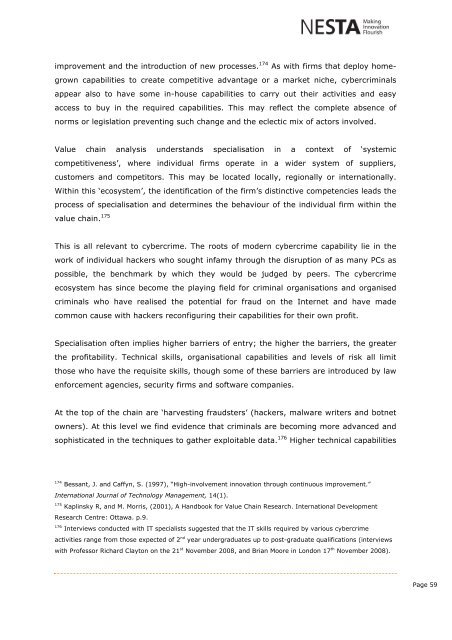NESTA Crime Online - University of Brighton Repository
NESTA Crime Online - University of Brighton Repository
NESTA Crime Online - University of Brighton Repository
Create successful ePaper yourself
Turn your PDF publications into a flip-book with our unique Google optimized e-Paper software.
improvement and the introduction <strong>of</strong> new processes. 174 As with firms that deploy home-<br />
grown capabilities to create competitive advantage or a market niche, cybercriminals<br />
appear also to have some in-house capabilities to carry out their activities and easy<br />
access to buy in the required capabilities. This may reflect the complete absence <strong>of</strong><br />
norms or legislation preventing such change and the eclectic mix <strong>of</strong> actors involved.<br />
Value chain analysis understands specialisation in a context <strong>of</strong> ‘systemic<br />
competitiveness’, where individual firms operate in a wider system <strong>of</strong> suppliers,<br />
customers and competitors. This may be located locally, regionally or internationally.<br />
Within this ‘ecosystem’, the identification <strong>of</strong> the firm’s distinctive competencies leads the<br />
process <strong>of</strong> specialisation and determines the behaviour <strong>of</strong> the individual firm within the<br />
value chain. 175<br />
This is all relevant to cybercrime. The roots <strong>of</strong> modern cybercrime capability lie in the<br />
work <strong>of</strong> individual hackers who sought infamy through the disruption <strong>of</strong> as many PCs as<br />
possible, the benchmark by which they would be judged by peers. The cybercrime<br />
ecosystem has since become the playing field for criminal organisations and organised<br />
criminals who have realised the potential for fraud on the Internet and have made<br />
common cause with hackers reconfiguring their capabilities for their own pr<strong>of</strong>it.<br />
Specialisation <strong>of</strong>ten implies higher barriers <strong>of</strong> entry; the higher the barriers, the greater<br />
the pr<strong>of</strong>itability. Technical skills, organisational capabilities and levels <strong>of</strong> risk all limit<br />
those who have the requisite skills, though some <strong>of</strong> these barriers are introduced by law<br />
enforcement agencies, security firms and s<strong>of</strong>tware companies.<br />
At the top <strong>of</strong> the chain are ‘harvesting fraudsters’ (hackers, malware writers and botnet<br />
owners). At this level we find evidence that criminals are becoming more advanced and<br />
sophisticated in the techniques to gather exploitable data. 176 Higher technical capabilities<br />
174 Bessant, J. and Caffyn, S. (1997), “High-involvement innovation through continuous improvement.”<br />
International Journal <strong>of</strong> Technology Management, 14(1).<br />
175 Kaplinsky R, and M. Morris, (2001), A Handbook for Value Chain Research. International Development<br />
Research Centre: Ottawa. p.9.<br />
176 Interviews conducted with IT specialists suggested that the IT skills required by various cybercrime<br />
activities range from those expected <strong>of</strong> 2 nd year undergraduates up to post-graduate qualifications (interviews<br />
with Pr<strong>of</strong>essor Richard Clayton on the 21 st November 2008, and Brian Moore in London 17 th November 2008).<br />
Page 59
















